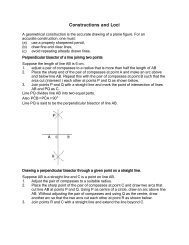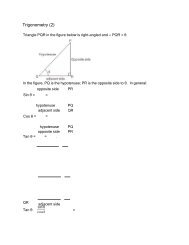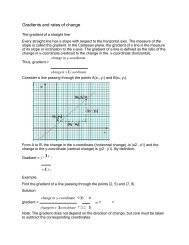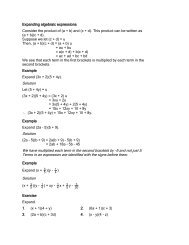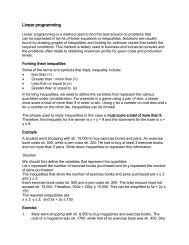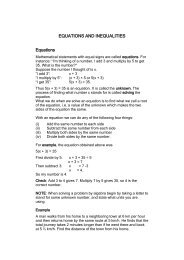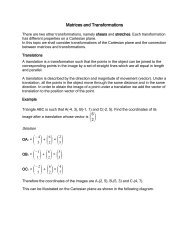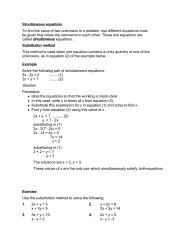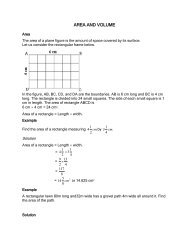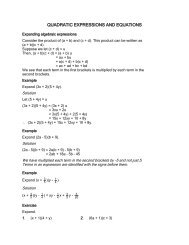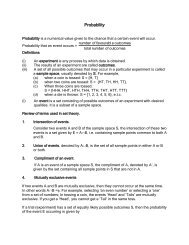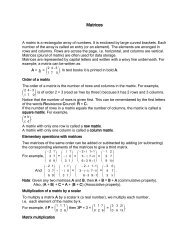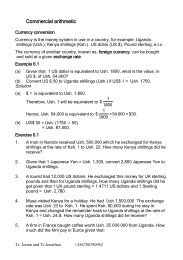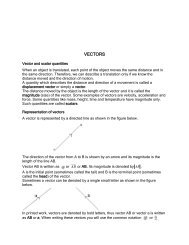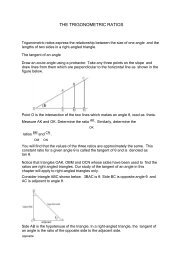20
Create successful ePaper yourself
Turn your PDF publications into a flip-book with our unique Google optimized e-Paper software.
Chapter 13 - Elasticity<br />
A PowerPoint Presentation by<br />
Paul E. Tippens, Professor of Physics<br />
Southern Polytechnic State University<br />
© <strong>20</strong>07
Chapter 13. Elasticity<br />
Photo © Vol. 10<br />
PhotoDisk/Getty<br />
BUNGEE jumping<br />
utilizes a long elastic<br />
strap which stretches<br />
until it reaches a<br />
maximum length that<br />
is proportional to the<br />
weight of the jumper.<br />
The elasticity of the<br />
strap determines the<br />
amplitude of the<br />
resulting vibrations. If<br />
the elastic limit for<br />
the strap is<br />
exceeded, the rope<br />
will break.
Objectives: After completion of this<br />
module, you should be able to:<br />
• Demonstrate your understanding of<br />
elasticity, elastic limit, stress, strain, , and<br />
ultimate strength.<br />
• Write and apply formulas for calculating<br />
Young’s s modulus, shear modulus, , and<br />
bulk modulus.<br />
• Solve problems involving each of the<br />
parameters in the above objectives.
Elastic Properties of Matter<br />
An elastic body is is one that returns to to its original<br />
shape after a deformation.<br />
Golf Ball<br />
Rubber Band<br />
Soccer Ball
Elastic Properties of Matter<br />
An inelastic body is is one that does not return to to its<br />
original shape after a deformation.<br />
Dough or Bread<br />
Clay<br />
Inelastic Ball
Elastic or Inelastic?<br />
An elastic collision loses<br />
no energy. The deformation<br />
on collision is fully<br />
restored.<br />
In an inelastic collision,<br />
energy is lost and the<br />
deformation may be<br />
permanent. (Click it.)
An Elastic Spring<br />
A spring is an example of an elastic body that<br />
can be deformed by stretching.<br />
x<br />
F<br />
A restoring force, F, F, acts<br />
in in the direction opposite<br />
the displacement of of the<br />
oscillating body.<br />
F = -kx
Hooke’s s Law<br />
When a spring is stretched, there is a restoring<br />
force that is proportional to the displacement.<br />
x<br />
m<br />
F<br />
F = -kx<br />
The spring constant<br />
k is a property of the<br />
spring given by:<br />
k<br />
F<br />
x<br />
The spring constant k is is a measure<br />
of the elasticity of the spring.
Stress and Strain<br />
Stress refers to the cause of a deformation, and<br />
strain refers to the effect of the deformation.<br />
The downward force F<br />
causes the displacement x.<br />
x<br />
F<br />
Thus, the stress is the force;<br />
the strain is the elongation.
Types of Stress<br />
A tensile stress occurs when<br />
equal and opposite forces are<br />
directed away from each other.<br />
F<br />
W<br />
Tension<br />
A compressive stress occurs<br />
when equal and opposite<br />
forces are directed toward<br />
each other.<br />
W<br />
F<br />
Compression
Summary of Definitions<br />
Stress is the ratio of an applied force F to the<br />
area A over which it acts:<br />
Stress<br />
F<br />
A<br />
Units : Pa <br />
N or<br />
m<br />
lb<br />
in.<br />
<br />
2 2<br />
Strain is the relative change in the dimensions or<br />
shape of a body as the result of an applied stress:<br />
Examples: Change in in length per unit length;<br />
change in in volume per unit volume.
Longitudinal Stress and Strain<br />
L<br />
L<br />
A<br />
A<br />
F<br />
For wires, rods, and bars,<br />
there is a longitudinal<br />
stress F/A that produces a<br />
change in length per unit<br />
length. In such cases:<br />
Stress<br />
<br />
F<br />
A<br />
Strain<br />
<br />
L<br />
L
Example 1. A steel wire 10 m long and<br />
2 mm in diameter is attached to the<br />
ceiling and a <strong>20</strong>0-N weight is attached<br />
to the end. What is the applied stress?<br />
L<br />
L<br />
A<br />
A<br />
F<br />
First find area of wire:<br />
2 2<br />
D (0.002 m)<br />
A <br />
<br />
<br />
4 4<br />
A = 3.14 x 10 -6 m 2<br />
Stress<br />
<br />
F<br />
A<br />
<br />
<strong>20</strong>0 N<br />
3.14 x 10 m<br />
-6 2<br />
Stress<br />
6.37 x 10 7 Pa
Example 1 (Cont.) A 10 m steel wire<br />
stretches 3.08 mm due to the <strong>20</strong>0 N<br />
load. What is the longitudinal strain?<br />
Given: L = 10 m; L L = 3.08 mm<br />
L<br />
Srain<br />
<br />
L<br />
L<br />
<br />
0.00308 m<br />
10 m<br />
L<br />
Longitudinal Strain<br />
3.08 x 10 -4
The Elastic Limit<br />
The elastic limit is the maximum stress a body can<br />
experience without becoming permanently deformed.<br />
2 m<br />
F<br />
2 m<br />
Stress<br />
<br />
F<br />
A<br />
W<br />
W<br />
W<br />
Okay<br />
Beyond limit<br />
If the stress exceeds the elastic limit, the final<br />
length will be longer than the original 2 m.
The Ultimate Strength<br />
The ultimate strength is the greatest stress a body can<br />
experience without breaking or rupturing.<br />
2 m<br />
F<br />
F<br />
Stress <br />
A<br />
W<br />
W<br />
W<br />
If the stress exceeds the ultimate strength,<br />
the string breaks!<br />
W<br />
W
Example 2. The elastic limit for steel is<br />
2.48 x 10 8 Pa. . What is the maximum<br />
weight that can be supported without<br />
exceeding the elastic limit?<br />
Recall: A = 3.14 x 10 -6 m 2<br />
L<br />
A<br />
A<br />
F<br />
Stress<br />
<br />
F<br />
A<br />
<br />
8<br />
2.48 x 10 Pa<br />
L<br />
F = (2.48 x 10 8 Pa) A<br />
F = (2.48 x 10 8 Pa)(3.14 x 10 -6 m 2 )<br />
F = 779 N
Example 2(Cont.) The ultimate strength<br />
for steel is 4089 x 10 8 Pa. . What is the<br />
maxi- mum weight that can be<br />
supported without breaking the wire?<br />
Recall: A = 3.14 x 10 -6 m 2<br />
L<br />
A<br />
A<br />
F<br />
Stress<br />
<br />
F<br />
A<br />
<br />
8<br />
4.89 x 10 Pa<br />
L<br />
F = (4.89 x 10 8 Pa) A<br />
F = (4.89 x 10 8 Pa)(3.14 x 10 -6 m 2 )<br />
F = 1536 N
The Modulus of Elasticity<br />
Provided that the elastic limit is not exceeded,<br />
an elastic deformation (strain) is directly<br />
proportional to the magnitude of the applied<br />
force per unit area (stress).<br />
Modulus of Elasticity<br />
<br />
stress<br />
strain
Example 3. In our previous example,<br />
the stress applied to the steel wire was<br />
6.37 x 10 7 Pa and the strain was 3.08 x 10 -4 .<br />
Find the modulus of elasticity for steel.<br />
L<br />
Modulus<br />
<br />
Stress<br />
Strain<br />
<br />
7<br />
6.37 x 10 Pa<br />
3.08 x 10<br />
-4<br />
L<br />
Modulus = <strong>20</strong>7 x 10 9 Pa<br />
This longitudinal modulus of of elasticity is is called<br />
Young’s Modulus and is is denoted by the symbol Y. Y.
Young’s s Modulus<br />
For materials whose length is much greater than the<br />
width or thickness, we are concerned with the<br />
longitudinal modulus of elasticity, or Young’s<br />
Modulus (Y).<br />
Young ' s modulus<br />
<br />
longitudinal stress<br />
longitudinal strain<br />
Y<br />
<br />
F / A <br />
FL<br />
lb<br />
Units : Pa or<br />
L / L AL<br />
2<br />
in.
Example 4: Young’s s modulus<br />
for brass is 8.96 x 10 11 Pa. . A<br />
1<strong>20</strong>-N weight is attached to an<br />
8-m length of brass wire; find<br />
the increase in length. The<br />
diameter is 1.5 mm.<br />
First find area of wire:<br />
8 m<br />
L<br />
1<strong>20</strong> N<br />
2 2<br />
D (0.0015 m)<br />
A <br />
A = 1.77 x 10 -6 m 2<br />
4 4<br />
FL FL<br />
Y or L<br />
AL<br />
AY
Example 4: (Continued)<br />
Y = 8.96 x 10 11 Pa; F = 1<strong>20</strong> N;<br />
L = 8 m; A = 1.77 x 10 -6 m 2<br />
8 m<br />
Y<br />
F = 1<strong>20</strong> N; L L = ?<br />
L<br />
FL FL<br />
or L<br />
1<strong>20</strong> N<br />
AL<br />
AY<br />
FL (1<strong>20</strong> N)(8.00 m)<br />
L<br />
<br />
-6 2 11<br />
AY (1.77 x 10 m )(8.96 x 10 Pa)<br />
Increase in length:<br />
L L = 0.605 mm
Shear Modulus<br />
A shearing stress alters only the shape of the body,<br />
leaving the volume unchanged. For example,<br />
consider equal and opposite shearing forces F<br />
acting on the cube below:<br />
A<br />
d<br />
F<br />
F<br />
l <br />
The shearing force F produces a shearing<br />
angle The angle is the strain and the<br />
stress is given by F/A as before.
Calculating Shear Modulus<br />
F<br />
l<br />
d A<br />
Stress is<br />
<br />
F force per<br />
unit area:<br />
The strain is the angle<br />
expressed in radians:<br />
F<br />
Stress <br />
A<br />
d<br />
Strain <br />
l<br />
The shear modulus S is defined as the ratio of the<br />
shearing stress F/A to the shearing strain :<br />
The shear modulus:<br />
Units are in in Pascals.<br />
F A<br />
S
Example 5. A steel stud (S(<br />
S = 8.27 x 10 10 Pa)<br />
1 cm in diameter projects 4 cm from the<br />
wall. A 36,000 N shearing force is applied to<br />
the end. What is the defection d of the stud?<br />
S<br />
l<br />
F<br />
d<br />
D (0.01 m)<br />
A <br />
<br />
<br />
4 4<br />
2 2<br />
Area: A = 7.85 x 10 -5 m 2<br />
F A F A Fl ; d <br />
Fl<br />
d l Ad AS<br />
d <br />
(36,000 N)(0.04 m)<br />
-5 2 10<br />
(7.85 x 10 m )(8.27 x 10 Pa)<br />
d = 0.222 mm
Volume Elasticity<br />
Not all deformations are linear. Sometimes an applied<br />
stress F/A results in a decrease of volume. . In such<br />
cases, there is a bulk modulus B of elasticity.<br />
Volume stress F A<br />
B <br />
Volume strain V<br />
V<br />
The bulk modulus is is negative<br />
because of of decrease in in V.
The Bulk Modulus<br />
Volume stress F A<br />
B <br />
Volume strain V<br />
V<br />
Since F/A is generally pressure P, , we may write:<br />
B<br />
<br />
P<br />
V / V<br />
<br />
PV<br />
V<br />
Units remain in Pascals (Pa)<br />
since the strain is unitless.
Example 7. A hydrostatic press contains 5<br />
liters of oil. Find the decrease in volume of<br />
the oil if it is subjected to a pressure of<br />
3000 kPa. . (Assume that B = 1700 MPa.)<br />
P<br />
PV<br />
B <br />
V / V V<br />
PV<br />
V<br />
<br />
B<br />
<br />
6<br />
(3 x 10 Pa)(5 L)<br />
9<br />
(1.70 x 10 Pa)<br />
Decrease in V;<br />
milliliters (mL):<br />
V V = -8.82 mL
Summary: Elastic and Inelastic<br />
An elastic body is is one that returns to to its original<br />
shape after a deformation.<br />
An elastic collision loses no energy. The deformation<br />
on collision is fully restored.<br />
An inelastic body is is one that does not return to to its<br />
original shape after a deformation.<br />
In an inelastic collision, energy is lost and the<br />
deformation may be permanent.
Summary<br />
Types of Stress<br />
A tensile stress occurs when<br />
equal and opposite forces are<br />
directed away from each other.<br />
F<br />
W<br />
Tension<br />
A compressive stress occurs<br />
when equal and opposite<br />
forces are directed toward<br />
each other.<br />
W<br />
F<br />
Compression
Summary of Definitions<br />
Stress is the ratio of an applied force F to the<br />
area A over which it acts:<br />
Stress<br />
F<br />
A<br />
Units : Pa <br />
N or<br />
m<br />
lb<br />
in.<br />
<br />
2 2<br />
Strain is the relative change in the dimensions or<br />
shape of a body as the result of an applied stress:<br />
Examples: Change in in length per unit length;<br />
change in in volume per unit volume.
Longitudinal Stress and Strain<br />
L<br />
L<br />
A<br />
A<br />
F<br />
For wires, rods, and bars,<br />
there is a longitudinal<br />
stress F/A that produces a<br />
change in length per unit<br />
length. In such cases:<br />
Stress<br />
<br />
F<br />
A<br />
Strain<br />
<br />
L<br />
L
The Elastic Limit<br />
The elastic limit is the maximum stress a body can<br />
experience without becoming permanently deformed.<br />
The Ultimate Strength<br />
The ultimate strength is the greatest stress a body can<br />
experience without breaking or rupturing.
Young’s s Modulus<br />
For materials whose length is much greater than the<br />
width or thickness, we are concerned with the<br />
longitudinal modulus of elasticity, or Young’s<br />
Modulus Y. Y<br />
Young ' s modulus<br />
<br />
longitudinal stress<br />
longitudinal strain<br />
Y<br />
<br />
F / A <br />
FL<br />
lb<br />
Units : Pa or<br />
L / L AL<br />
2<br />
in.
The Shear Modulus<br />
F<br />
l<br />
d A<br />
Stress is<br />
<br />
F force per<br />
unit area:<br />
The strain is the angle<br />
expressed in radians:<br />
F<br />
Stress <br />
A<br />
d<br />
Strain <br />
l<br />
The shear modulus S is defined as the ratio of the<br />
shearing stress F/A to the shearing strain :<br />
The shear modulus:<br />
Units are in in Pascals.<br />
F A<br />
S
The Bulk Modulus<br />
Volume stress F A<br />
B <br />
Volume strain V<br />
V<br />
Since F/A is generally pressure P, , we may write:<br />
B<br />
<br />
P<br />
V / V<br />
<br />
PV<br />
V<br />
Units remain in Pascals (Pa)<br />
since the strain is unitless.
CONCLUSION:<br />
Chapter 13 - Elasticity



